Ahh, artichokes. A thistle that has one of the worst reputations for being difficult to prep and cook. Yup, that's right. This vegetable is a perennial thistle that belongs to the sunflower family. But no need to worry; once you have mastered how to prep artichokes cooking them any which way your heart desires will be a piece of cake!
{{ This tutorial for how to prep artichokes and the corresponding posts that go with it were made in partnership with California Grown! We received compensation in exchange for these posts. Opinions are always our own. If we don’t love it, you don’t hear about it. Thanks for your continued support! }}
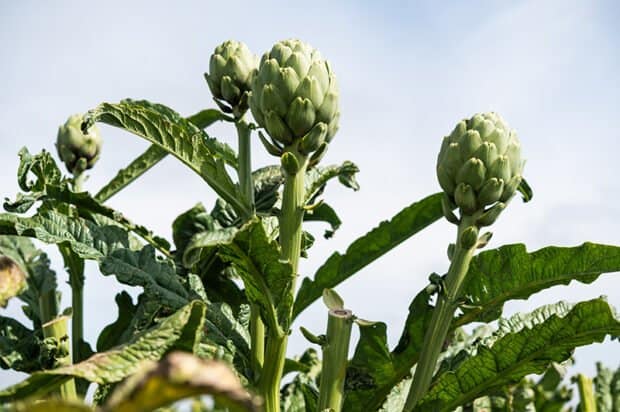
Photo credit James Collier for California Grown.
If you are looking to prepare and cook fresh artichokes, I have you covered!
But, first I want to share with you a few fun artichoke factoids like where artichokes are grown, how they grow, and how they are harvested.
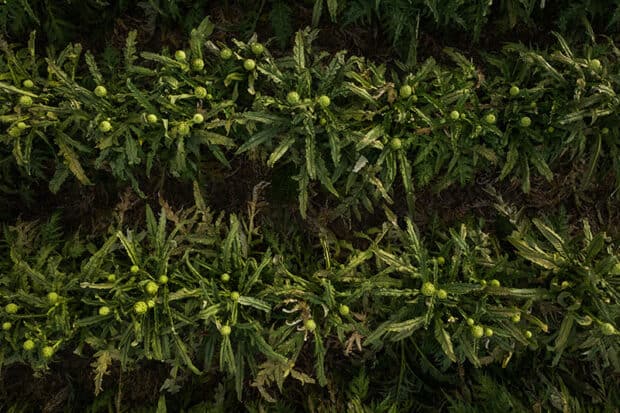
Photo credit James Collier for California Grown.
When are artichokes in season?
From March through May, fresh artichokes are at their peak. But canned, jarred, and frozen artichoke hearts from California are available all year round.
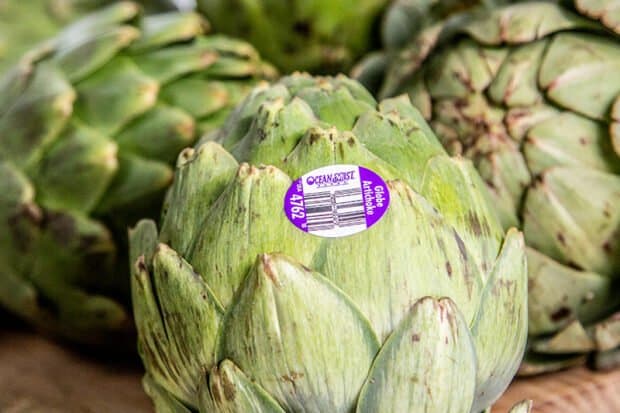
Who is the largest commercial grower of artichokes in the United States?
Did you know that California produces 100% of the commercial artichoke crop in the United States? It's true. Artichokes were even named the official state vegetable of California in 2013!
I recently had the pleasure of visiting Ocean Mist Farms in Castroville, California, home of the annual Castroville Artichoke Festival and "The Artichoke Capital of the World".
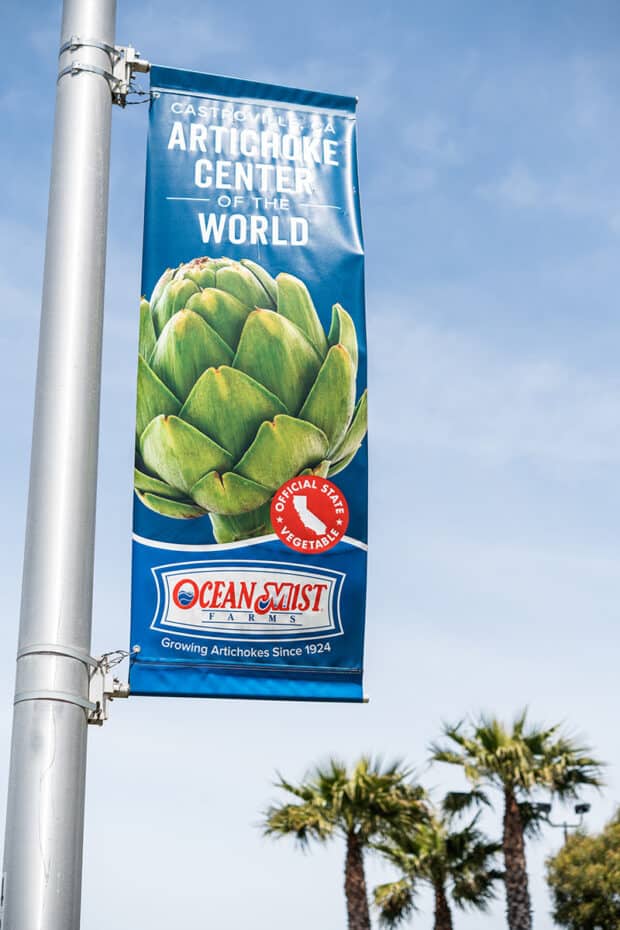
Ocean Mist Farms
Ocean Mist Farms was established in 1924 and is the largest grower of fresh artichokes in North America.
They farm artichokes year-round in three ideal California growing regions: Castroville, Oxnard and Coachella – plus Baja, California.
Each of these areas in California is known for fertile ground and productive microclimates.
Photo credit James Collier for California Grown.
Ocean Mist doesn't only grow artichokes though, they grow 30 other fresh vegetables too!!!

Photo credit James Collier for California Grown.
How do artichokes grow?
As you can see from the image above at Ocean Mist, artichokes are very large plants!
These thistles have large, toothy leaves that are light green to silvery gray in color, and grow around 32-inches in length. Together, the leaves form large rosettes that can measure six to eight feet across!
From the center of the plant, flower stalks emerge with a green or purple bud on the end of each stalk – this flower bud is the edible part. The largest, meatiest artichoke that grows at the top of the plant is referred to as the "Crown" artichoke.
Side branches will also grow from the main stalk and produce smaller heads, which are often sold as “baby artichokes.”
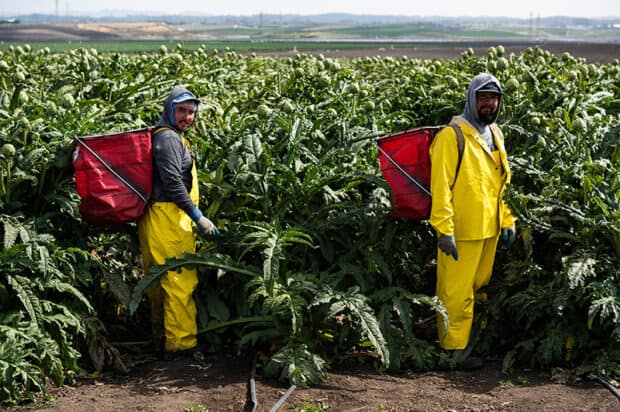
Photo credit James Collier for California Grown.
How are artichokes harvested?
Ocean Mist Farms artichokes are grown year-round in multiple growing regions throughout Southern California.
The farmworkers walk down the rows of artichokes with empty canastas on their back. In each gloved hand, they hold a small knife between their palm and their thumb. The artichokes are removed from the plant by slicing the stalk just below the base of the artichoke.
When the canastas are full they can weigh around 100 pounds each!! Talk about hard work that requires very skilled labor!
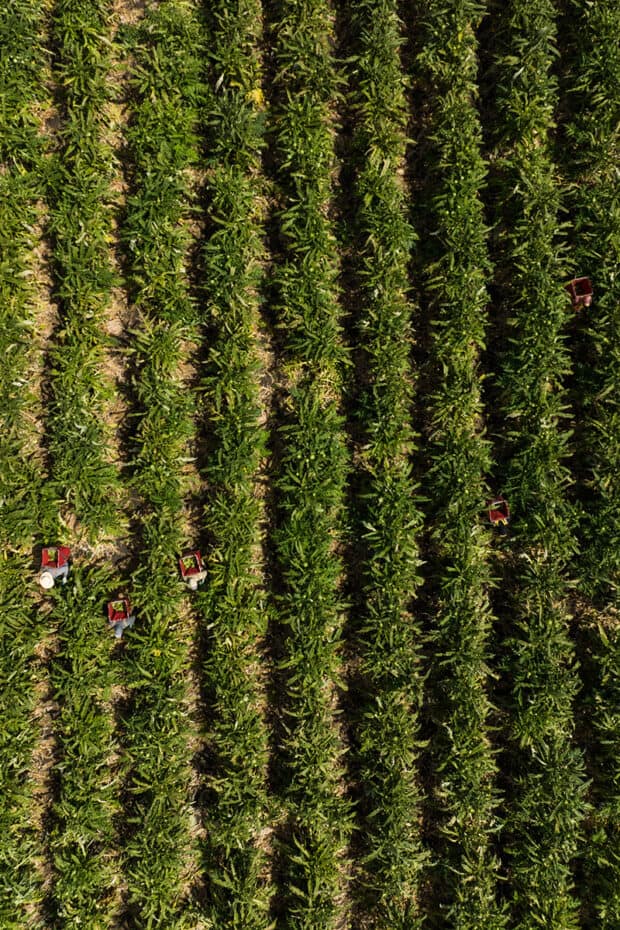
Photo credit James Collier for California Grown.
Every artichoke plant is hand-harvested up to 30 times per season with stringent quality standards.
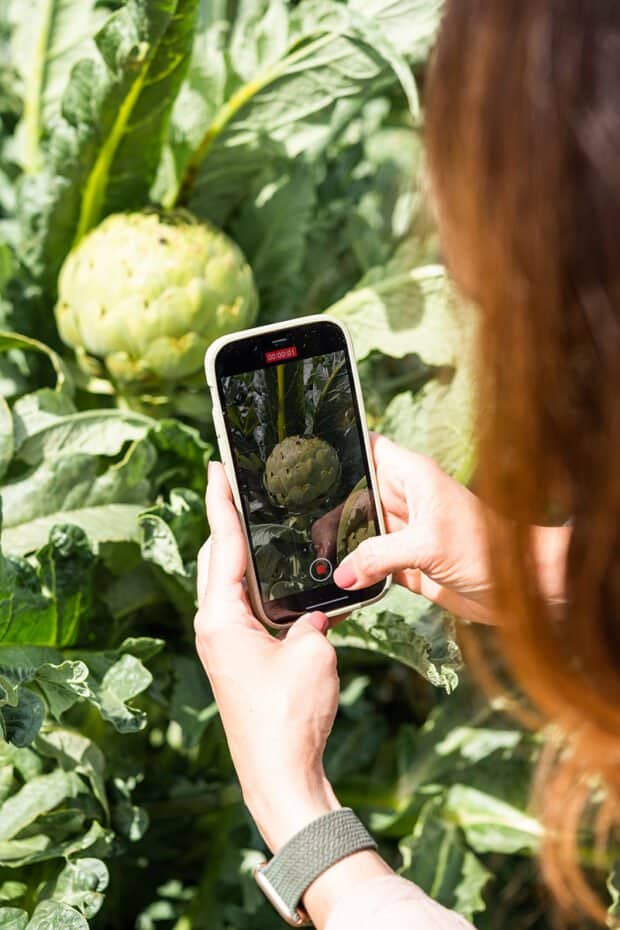
Photo credit James Collier for California Grown.
Is the whole artichoke edible?
No, the whole artichoke itself is not edible. The hairy choke within and the pointed, tough outer section of the leaves are the only parts you can't consume.
The choke isn't deadly, and neither is the outer part of the leaves. However, as it's name "choke" suggests, they are a choking hazard.
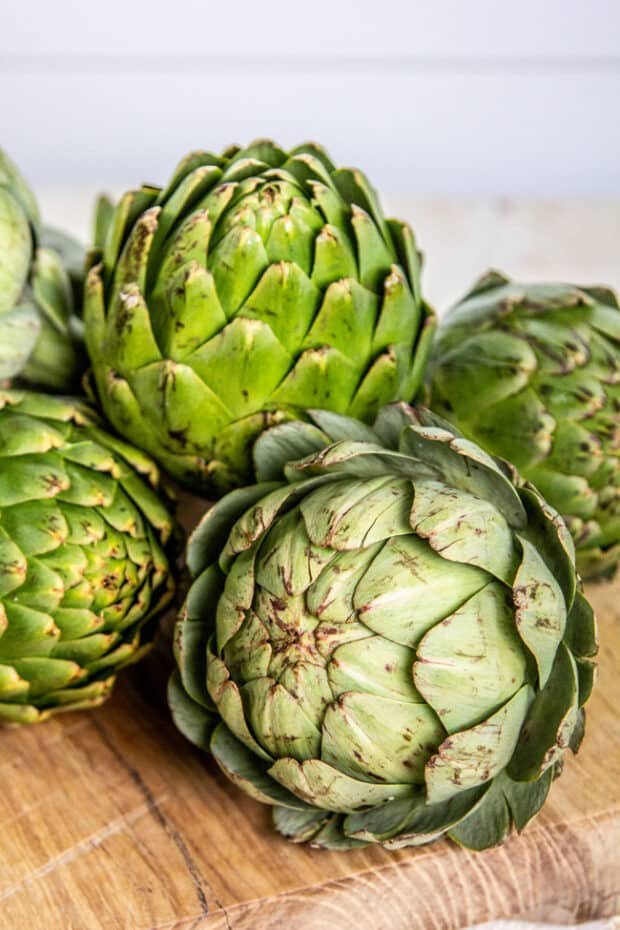
How to prep artichokes
Prepping artichokes can be intimidating, when you have never done it before, but really the process is quite simple.
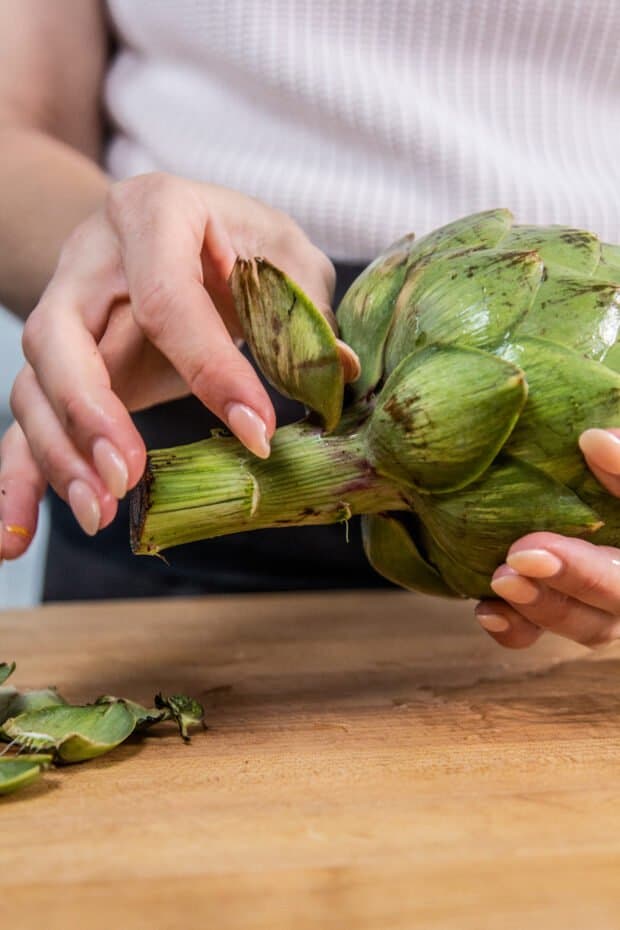
Step 1
Remove the bottom leaves and slice off the stem.
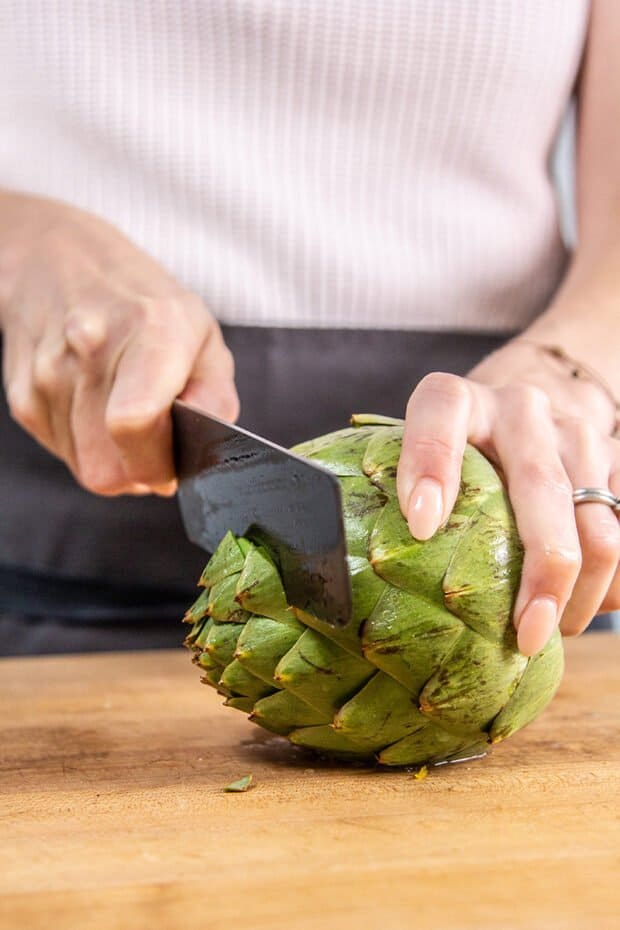
Step 2
Remove around ½ an inch of the artichoke's top with a sharp knife.
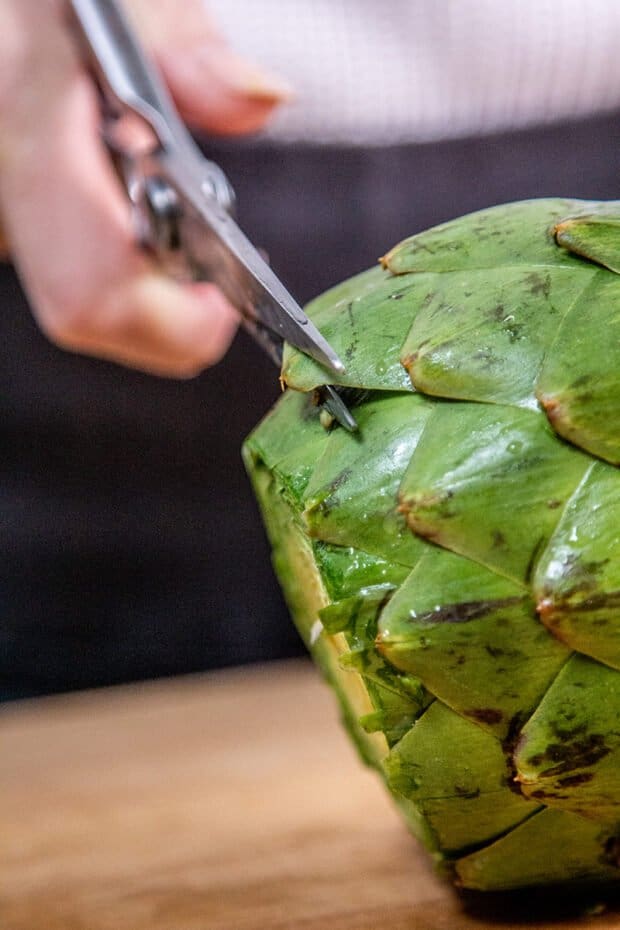
Step 3.
Carefully, snip the pointy tops of the outer leaves using sharp kitchen scissors to give them flat edges.
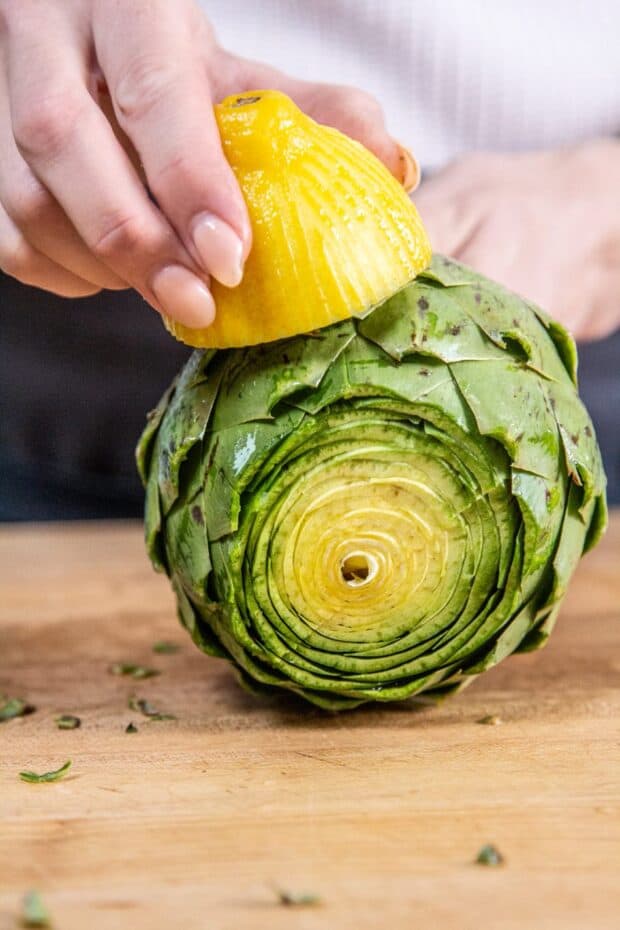
Step 4
Cut a lemon in half and rub it all over the artichoke, especially where you’ve cut it.
Similar to other browning fruits and veggies, lemon juice keeps the artichoke from oxidizing (browning) once you have cut into it.
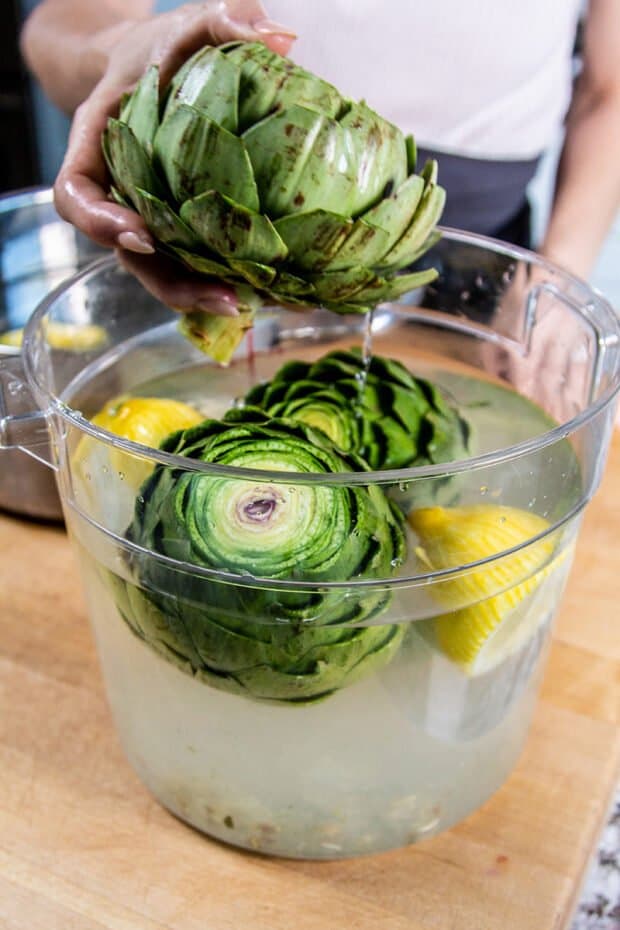
Step 5
Next fully submerge your artichoke into an ice-bath that has both lemon halves & lemon juice in it.
Repeat this process with any remaining artichokes.
At this point you can move on to cooking methods like steaming, boiling, or microwaving where the artichoke is called for being cooked whole.
If you need to remove the hairy choke from the center of the artichoke before cooking like when roasting artichokes in the oven continue with the steps below.
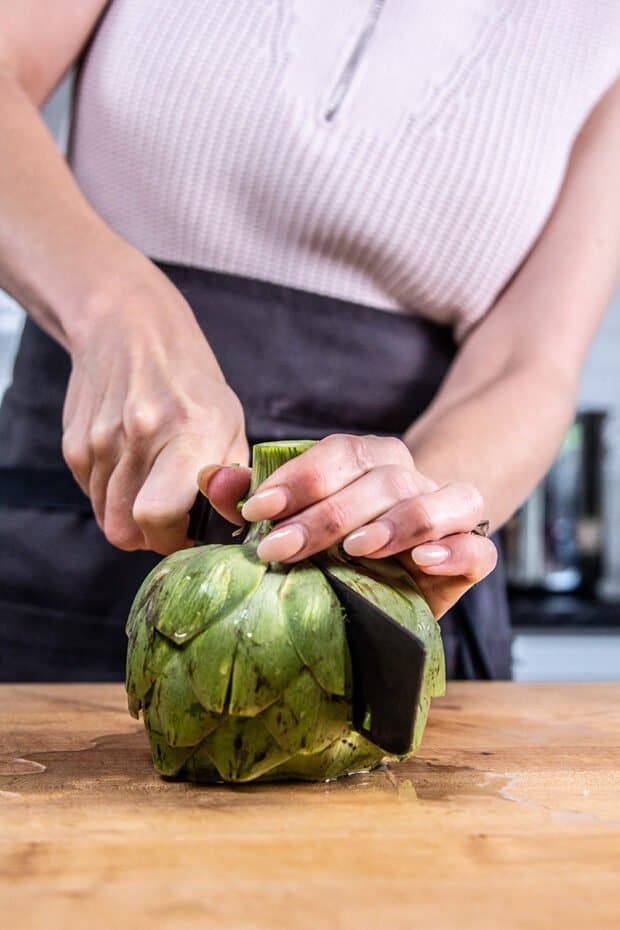
Step 6
Place the artichoke upside down on a cutting board. Then, use a sharp knife to slice through the stem end of the artichoke until the artichoke is in two halves.
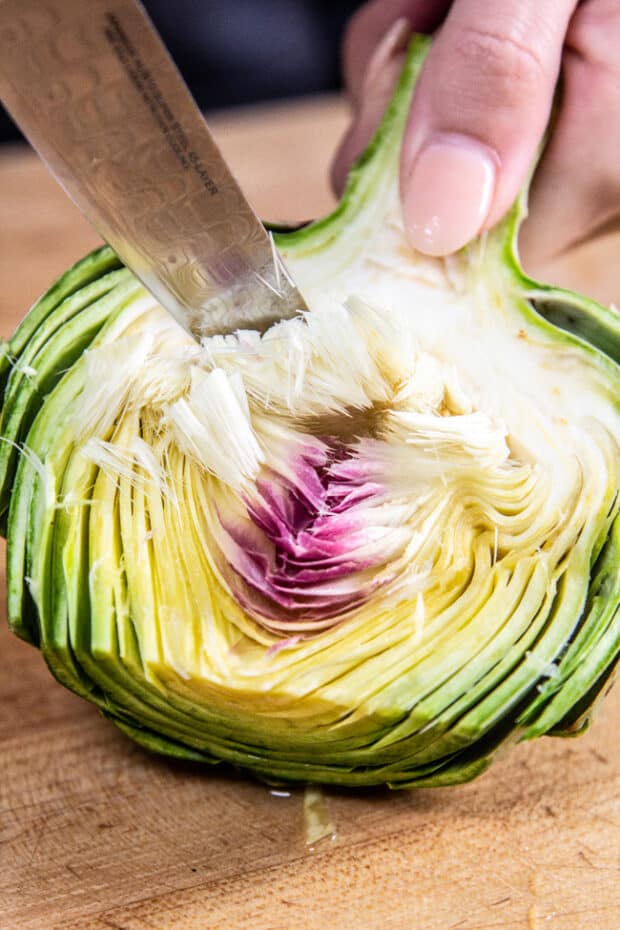
Step 7
Use a pairing knife to remove the center petals and the hairy choke. A small spoon also works wonders as a tool for this.
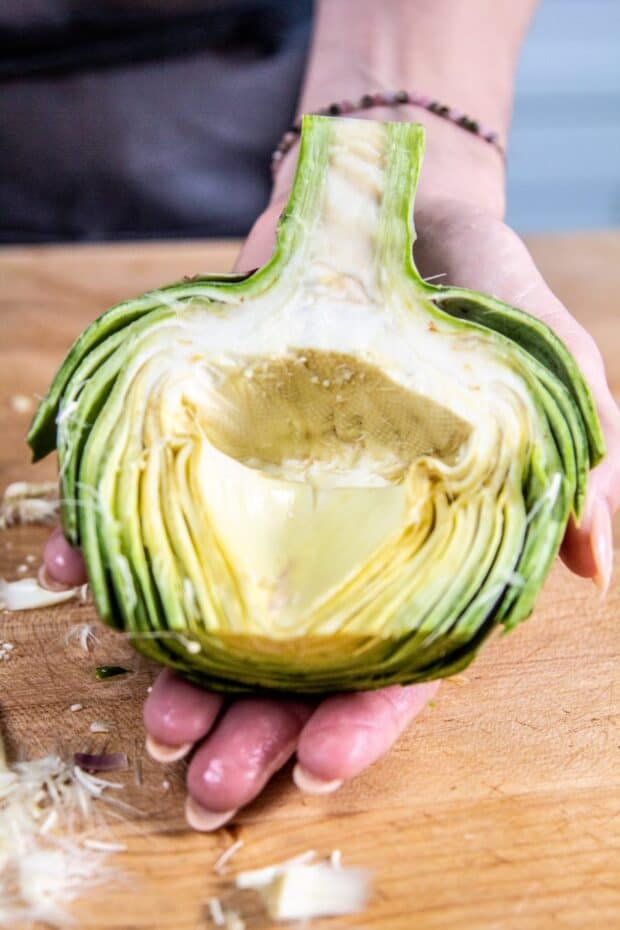
Step 8
Rub the artichoke all over the inside with lemon and cook as desired.
I prepare my artichokes this way when I plan to roast or grill them.
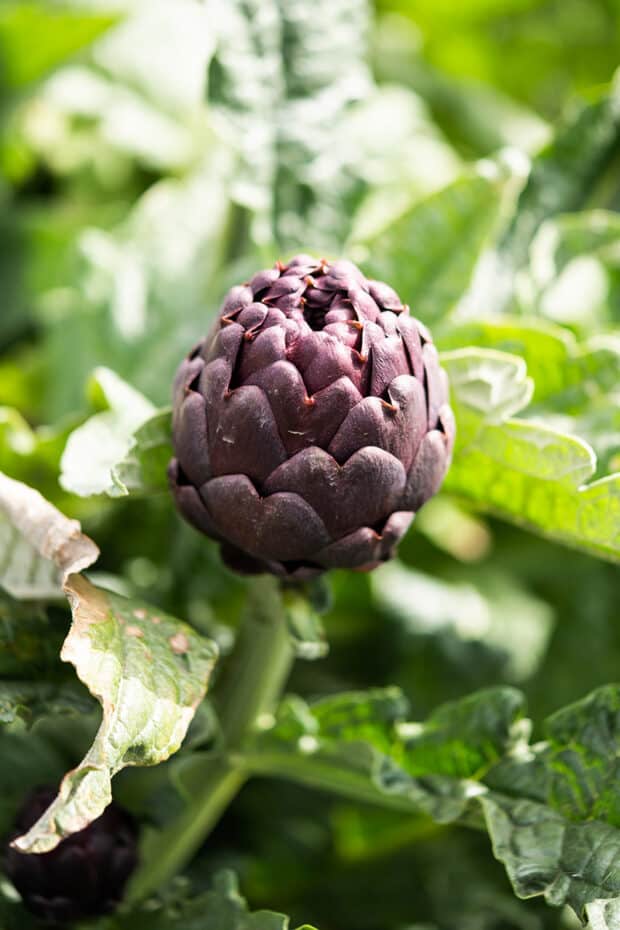
Photo credit James Collier for California Grown.
What is the difference between raw vs cooked artichoke texture?
Artichokes have a more rigid texture and a tart flavor when eaten raw. Cooking softens the texture and deepens the flavor.
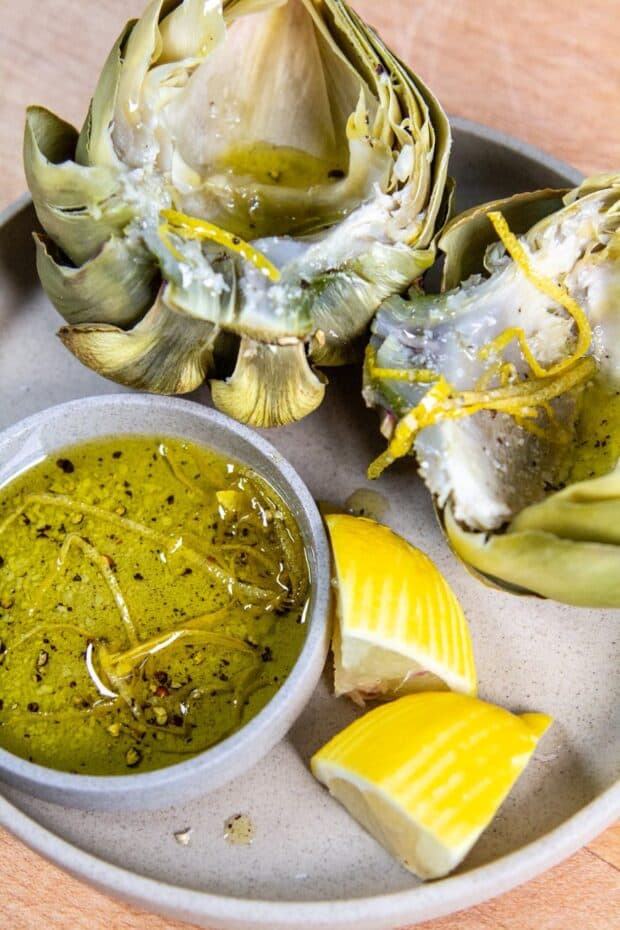
What does an artichoke taste like?
Artichokes have a mild nutty flavor comparable to asparagus and brussels sprouts.
Now that you know how to prep artichokes here are some easy ways you can cook them.
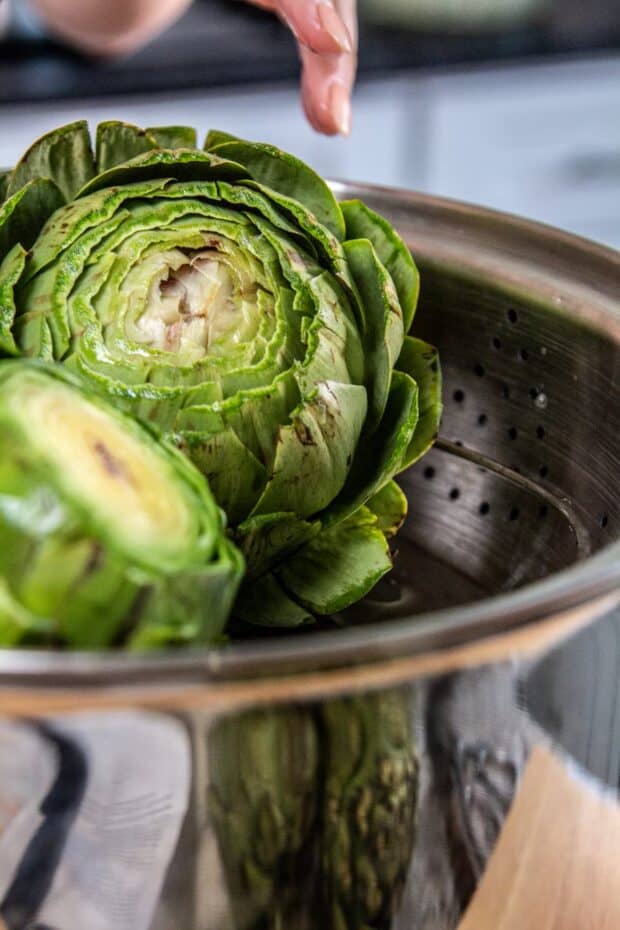
The easiest way to steam an artichoke.
This is the first artichoke preparation method I ever learned. It is easy, mostly hands off, and yields really flavorful artichokes every single time.
Click here for how to steam an artichoke.
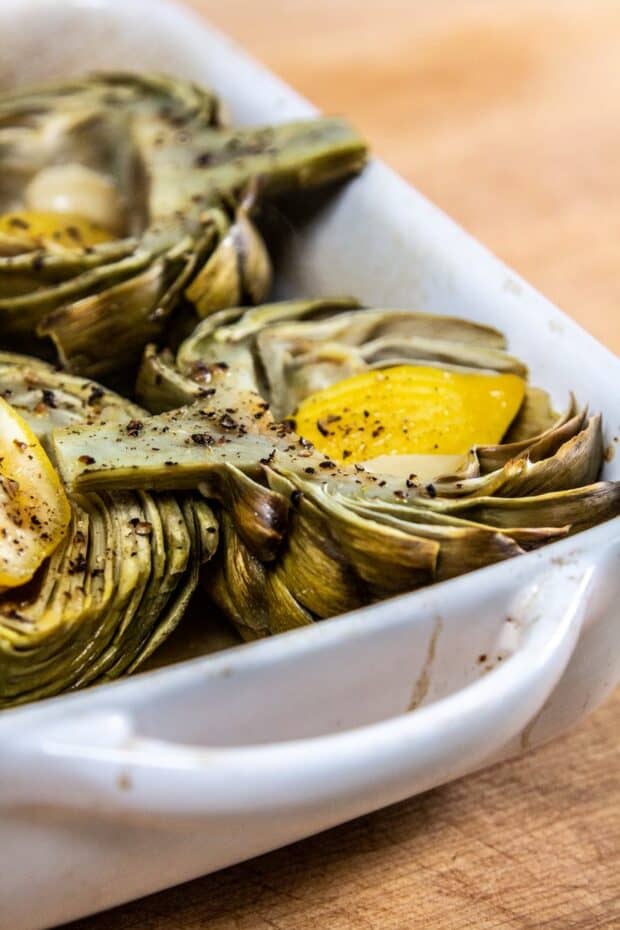
How to bake an artichoke.
I first learned how to roast an artichoke from watching Adeena Sussman and I have been hooked ever since. This is my daughter and I's favorite way to cook and eat an artichoke.
Click here to learn how to roast an artichoke.
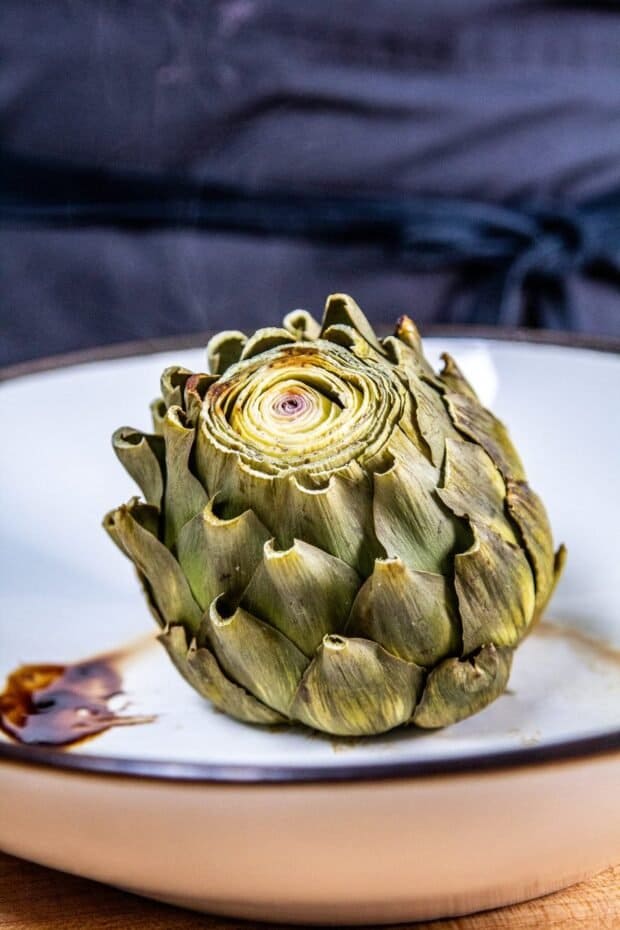
Do you know how to microwave a whole artichoke?
When you are in a hurry or only cooking for 1 you may think you shouldn't reach for a fresh artichoke.
However, you can actually prep and cook a delicious artichoke in less than 20 minutes with the help of the microwave.
How to microwave a whole artichoke.

How to boil an artichoke.
While I am not a super fan of boiling artichokes it is a cooking method that is pretty popular.
I often boil artichokes when I plan to serve them stuffed with cheese and breadcrumbs then baked.
Click here to learn how to boil an artichoke.
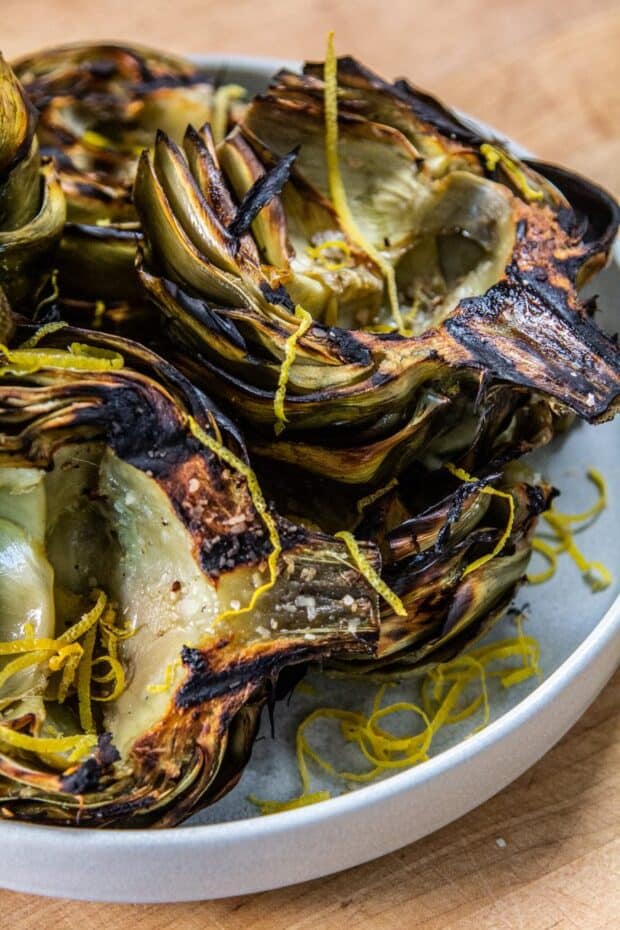
How to grill an artichoke.
My son Kash loves grilled artichokes so much that he actually took leftovers in his lunchbox to school once!
If you plan to grill artichokes it is important to note that you must par-cook them by steaming, boiling, or microwaving first.
Click here to learn how to grill an artichoke.
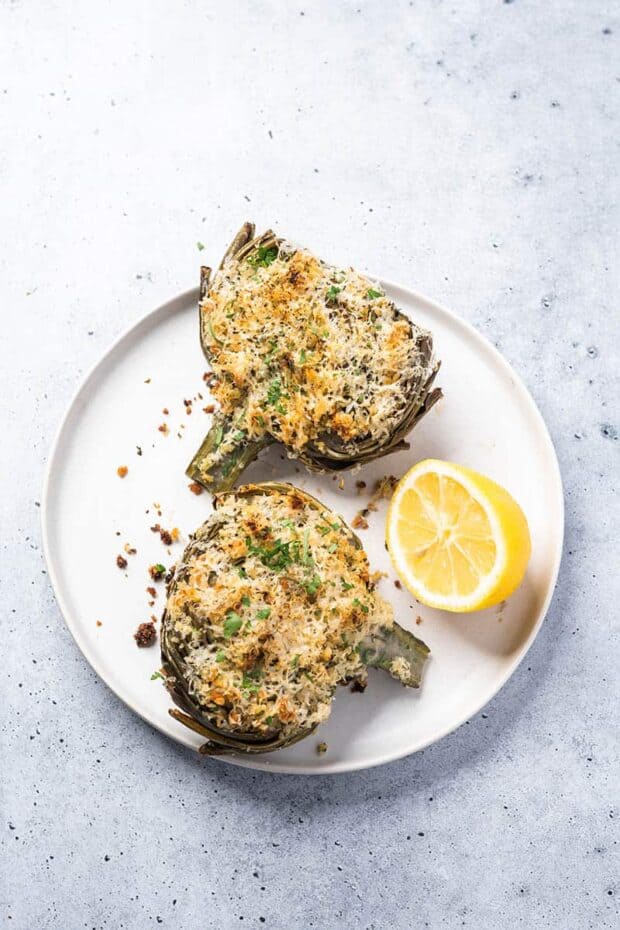
How to stuff an artichoke.
This California-inspired Stuffed Artichoke recipe from California Grown is hearty enough to eat like a meal, but also party-perfect when you are having guests over.
If you plan to stuff artichokes it is important to note that you must par-cook them by steaming, boiling, or microwaving first.
Click here for this stuffed artichoke recipe.
What does par-cook mean?
Some methods of preparing artichokes require being par-cooked. But, what does that even mean?
Par-cooking is a process by which food is partially cooked so that it can be finished or reheated later. Restaurants use this method quite often, however it can also be very useful to the home cook especially when cooking dishes like grilled or stuffed artichokes.
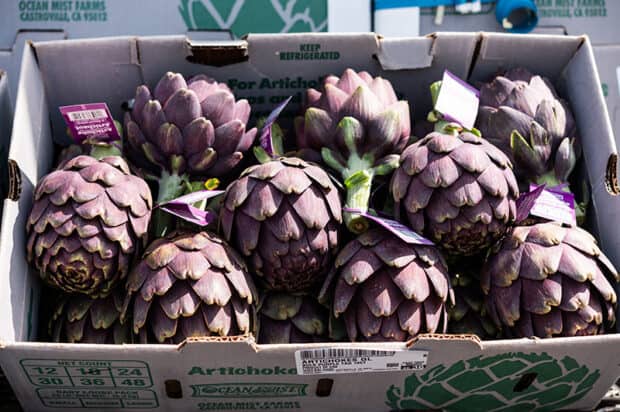
Photo credit James Collier for California Grown.
If you have any tips or tricks for prepping artichokes or you tried our method and found it helpful I would be so grateful if you would rate the recipe and let me know what you think in the comments below!
PrintHow To Prep Artichokes
Prepping a fresh artichoke can seem like an intimidating task, but once you know what to do I assure you it couldn't be any easier. Although, it is a bit messy - I think sometimes the mess is part of the fun!
- Prep Time: 20
- Total Time: 20 minutes
- Yield: 4 servings 1x
- Category: How to
- Method: Cleaned & Snipped
- Cuisine: American
Ingredients
4 artichokes
2 lemons, halved
Instructions
Create a lemon ice bath for the artichokes by filling a large container with ice and water, squeeze in the juice of 3 of the lemon halves and toss the lemon halves in as well. Set aside.
Remove the bottom leaves of the artichoke by pulling them off and slice off the stem.
Remove around ½ an inch of the artichoke's top with a sharp knife revealing the yellow inside of the artichoke.
Carefully, snip the prickly parts of the outer leaves using sharp kitchen scissors to give them flat edges.
Rub the remaining lemon half all over the artichoke, paying special attention to the areas where you’ve cut it.
Next fully submerge the artichoke into the prepared ice-bath.
Repeat this process with any remaining artichokes.
At this point you can move on to cooking methods like steaming, boiling, or microwaving where the artichoke is called for being cooked whole.
If you need to remove the hairy choke from the center of the artichoke before cooking like when roasting artichokes in the oven or grilling continue with the steps below.
Place the artichoke upside down on a cutting board. Then, use a sharp knife to slice through the stem end of the artichoke until the artichoke is in two halves.
Use a pairing knife to remove the center petals and the hairy choke. A small spoon also works wonders as a tool for this.
Rub the artichoke all over the inside with lemon and cook as desired.
Nutrition
- Serving Size: 1 artichoke
- Calories: 77
- Sugar: 2.7 g
- Sodium: 72.9 mg
- Fat: 0.6 g
- Carbohydrates: 18.5 g
- Protein: 3.7 g
- Cholesterol: 0 mg
Are you looking for the best recipes with jarred, canned, or frozen artichoke hearts?
These are a few of my absolute favorite recipes and resources to use year-round when I want to cook with artichokes.
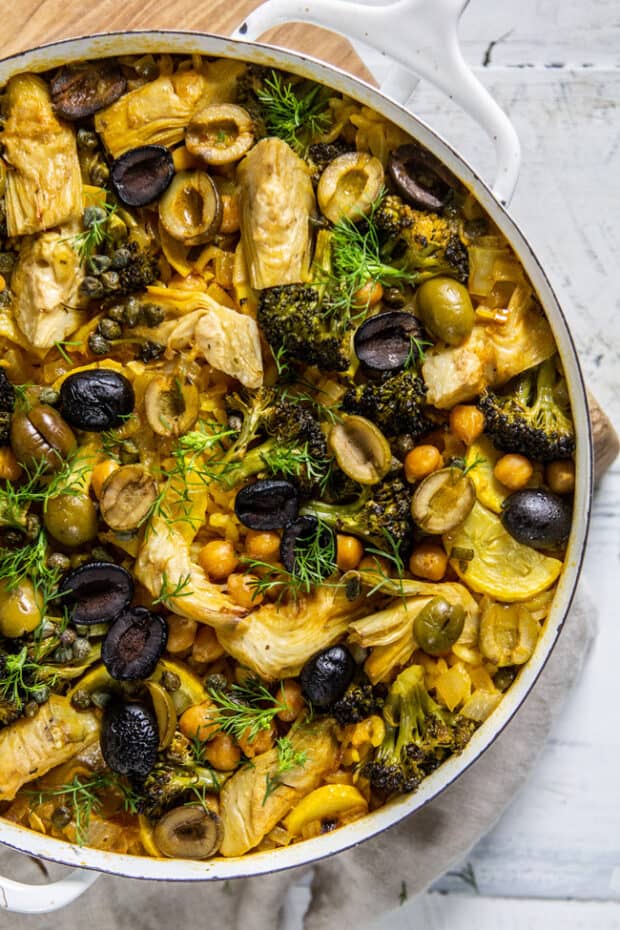
Oven Baked Paella with Artichoke Hearts and Seasonal Veg
Are you looking for the best recipes with canned or frozen artichoke hearts? This is my absolute favorite!
This easy Paella is packed with vegetables like artichoke hearts, black and green olives, capers, broccoli, yellow squash, onions, garlic, and more!
Click here for this vegan paella recipe!

Oven Baked Paella with Artichokes, Sausage, & Chicken
This Paella recipe has a meaty flare. It is just as easy as the veggie loaded version above and can be a great way to use up the odds and ends in your fridge like leftover grilled chicken.
It's a hearty meal that will find its way into your dinner rotation again and again!

20+ Recipes that Will Teach You How to Cook Artichokes Like a Pro
Have you ever Googled, ” How to cook artichokes?”. Artichokes are one of those vegetables that eludes a lot of home cooks, but California Grown is seeking to change that with this article that will teach you how to cook artichokes like a pro!
Click here for more artichoke recipes!
Are you interested in learning more about how artichokes are grown in California?
Monterey county greets you with the freshest seafood from the ocean and pairs it with the freshest produce from the land, and right smack in the middle of it all is Pezzini Farms -a food lover’s roadside attraction that is not to be missed!
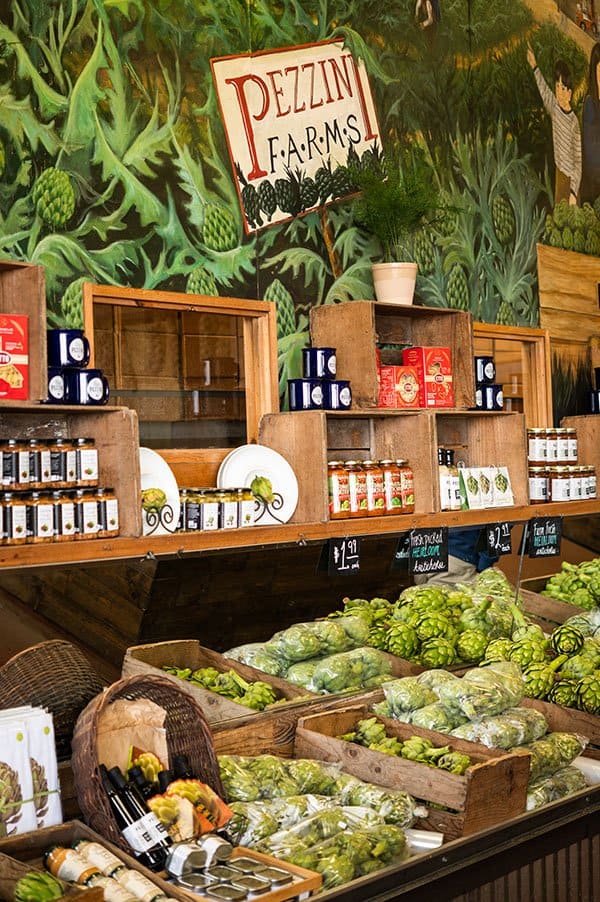
Celebrate The Best Of Artichoke Season At Pezzini Farms!
Recently, I had the pleasure of meeting Sean Pezzini, a 4th generation artichoke farmer at Pezzini Farms in Castroville, California.
His family’s heirloom artichokes were brought here from Italy by his great grandfather.
Click here to read more about Pezzini Farms!!
Want to be a part of our online community outside of the blog? It’s easy!! All you have to do is follow @THISMESSISOURS on FACEBOOK, INSTAGRAM, TWITTER, YOUTUBE, TIKTOK or PINTEREST to see cooking demos, and peeks into our day to day life.

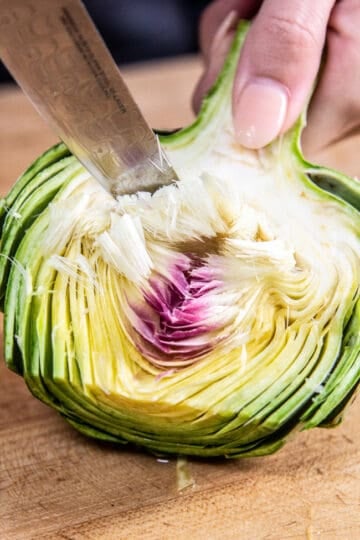
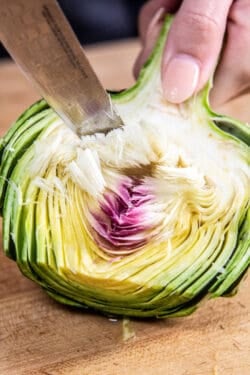
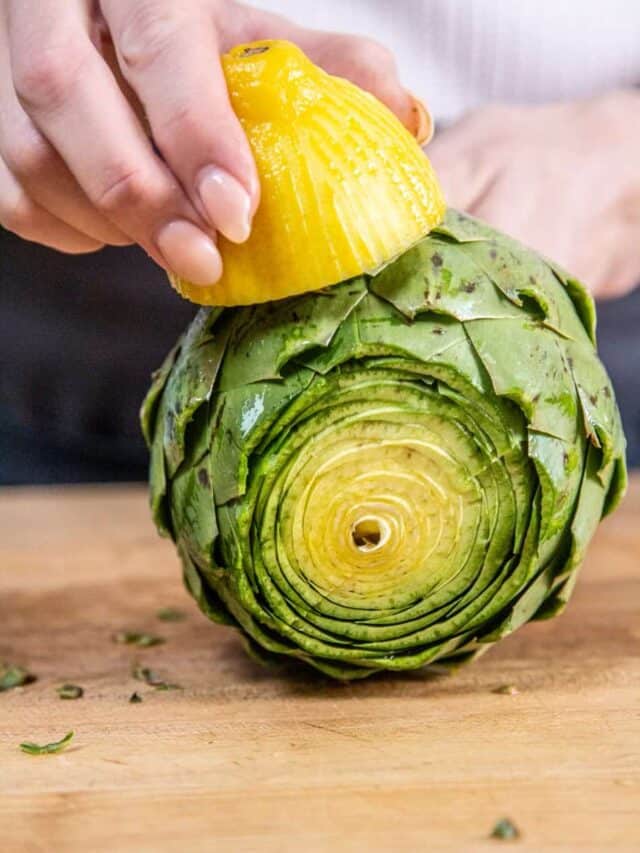



Leave a Reply